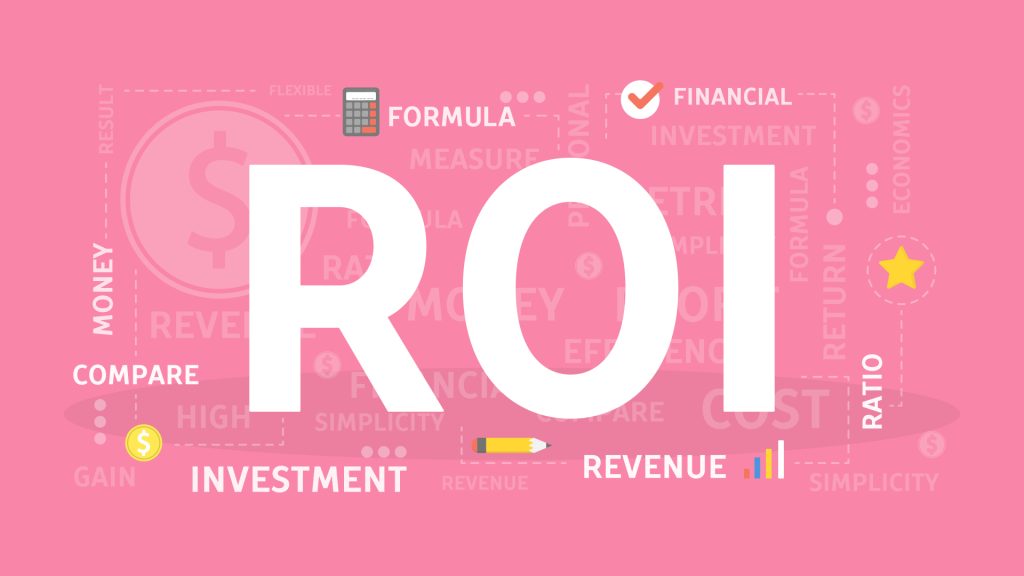How to Calculate ROI on Custom Web or App Development

When companies invest in custom web or app development, they’re not buying code; they’re buying outcomes: more revenue, improved customer experience, operational efficiency, and scalability in the long run. But how do you actually measure these outcomes? That’s where Return on Investment (ROI) comes in.
Whether you’re a startup founder, CFO, or digital strategist, understanding how to measure ROI in web or app development is essential to making data-backed decisions. In this guide, we’ll break it down simply, no fluff, just frameworks, numbers, and innovative strategies.
Why Measuring ROI Matters More Than Ever

In 2025, businesses globally are expected to spend over $872 billion on custom software and the stakes have never been higher. In 2025 alone, world-wide expenditure on bespoke software and application development will surpass $872 billion, indicating a speeding-up digital revolution in every sector.
Business houses are going all out for tailored digital solutions to outcompete others, streamline processes, and keep pace with changing customer demands. But the issue here is close to 30% of all IT projects fail, usually because of fuzzy objectives, changing priorities, or the inability to show real business value.
That failure isn’t always technologically motivated; it’s frequently a matter of mathematics.
Lacking a clear way to measure ROI, many development projects turn into passion projects instead of profit drivers. That’s particularly dangerous in today’s environment, where each dollar spent must be justified.
So, what distinguishes the best-selling digital products from the ones that quietly go dark in obscurity?
What Is Helpful Anticipatory ROI Measurement
ROI is not just a dollar-and-cents calculation; it’s a guide to making informed decisions. Done correctly, it assists teams in:
- Prioritizing feature-rich business drivers
- Rationalize development spend to executives or investors
- Prevent scope creep and cost blowouts
- Align cross-functional teams with common business objectives
More significantly, ROI measurement makes development a value creator rather than a cost center. It turns the conversation around from “How much is this app going to set us back?” to “How much value will this solution free up for our business?”
By incorporating ROI thinking into each phase of your bespoke development process, from ideation to after-launch, you give your project the greatest likelihood of success. Not only technically, but commercially.
The Simple ROI Formula (And Why It’s Insufficient)

Let’s begin with the most used formula by business:
ROI = (Net Profit / Total Investment) × 100
At first glance, it seems easy enough to calculate your profit, divide it with what you invested, and then multiply it by 100 percent. And that’s your Return on Investment.
But in custom web or application development, this formula oversimplifies a complex universe. Custom development has more than one cost component and long-term value generation, which can’t be captured through a simple one-size-fits-all formula.
The real challenge lies in specifying two parameters: “Net Profit” and “Total Investment.” Both can be difficult to quantify meaningfully without a systematic breakdown. Let’s do that.
Need a Reliable Web Development partner to help grow your Business?
Our Experts Can Help!
What to Include in “Total Investment”
Your Total Investment might include more than just the original development expense. For calculating ROI correctly, you should include both direct and indirect expenses that have occurred after launch included. Here’s a detailed look at what you can include:
Development Expenses
These are your vital expenses directly relating to creating the product:
- Developer wages or agency-outsourced fees
- Project manager, analyst, and consultant hours worked
- UI/UX design, wireframes, and prototyping expenses
- Testing, QA (Quality Assurance), and debugging cycles
Technology Stack & Infrastructure
Every app or website runs on a tech stack to function. Here, costs are usually under projected:
- Software licenses (e.g., CMS, frameworks, APIs)
- Hosted monthly or annual expenses
- Infrastructure expenses, including cloud providers (AWS, Azure, GCP)
- DevOps tools and automated deployment environments
Post-Launch Expenses
Deployment is only the beginning here’s the beginning of a new cost cycle:
- Continued maintenance and technical support
- Bug fixes, patches to software, and regular security updates
- Continued feature enhancement and development based on customer feedback
- Listing and renewal fees for app store (especially for mobile apps)
Training and Onboarding
New tools bring about change and change is about learning curves:
- Time invested in training internal staff on new platform use
- Temporary productivity loss during transition times
- Creation of training materials or user manuals
Marketing & Rollout Costs
You may have the greatest app in the world, but nobody will use it unless they’re aware that it exists:
- Early product launch campaigns
- Website content updates and marketing materials
- Paid advertising, SEO, and user acquisition efforts
Looking for a technical partner to help grow your Ecommerce store?
We Can Help!
Why Just Applying the Formula Can Be Misleading
Using the classic ROI formula without considering these elements may give only half or a wrong picture. For instance, you may believe a project has high ROI because it created $100,000 in earnings, but when your Total Investment, including hidden post-launch and training costs, is $90,000, your actual ROI is only 11% rather than the 100% it appears to be at first glance.
Worse still, the failure to include time costs or opportunity costs can result in overestimating value and risk underestimation. Suppose the custom solution replaced three steps that involved manual labor. What is the time saved per employee per month worth? That benefit must be added as well.
Tip: Build a Cost Timeline
To make it more realistic to measure ROI, attempt to create a cost timeline with a graphical representation of how much time you spend during all project phases. You can:
- Use a spreadsheet where you have columns for every cost category and rows for monthly or quarterly periods
- Use tools like Clarity.fm to obtain advice from experts on estimating future or unforeseen costs
- Sync cost tracking with your project management software (like Jira or Asana) to monitor hours worked
- This seamless process doesn’t just make your ROI estimates more accurate; it also helps you see where you’re over-spending or where you can streamline.
What to Include in “Net Profit”

When dealing with ROI, few give much thought to anything beyond revenue growth, but that’s only half the equation. For custom mobile or web application development, Net Profit typically is a mix of revenue growth, cost savings, time saved, and intangible gains that add up to long-term value to the company.
Let’s cut to the chase:
Revenue Gains
These are the most straightforward ways your own platform is driving your top line growth:
- Customer acquisition: Your application or website can attract new customers via organic search, SEO, app stores, or web marketing.
- Recurring revenue: Subscription, in-app purchases, or SaaS models can generate repeat monthly, predictable streams of revenue.
- eCommerce sales: A more streamlined user experience (UX) in a custom storefront tends to produce higher cart values and abandonment reductions.
- Upselling/cross-selling: Smartly placed product recommendations and clever algorithms can increase order value and customer lifetime value (CLV).
Stat: Effective UX can influence up to 400% conversion rates, as Forrester studies suggest.
Cost Savings
Saving money is like making money. Think about:
- Workflow automation: Manual repetitive tasks, for example, calendaring or data input, are automated, freeing up people for more valuable work.
- Lower support costs: Self-service portal or chatbot within your app reduces reliance on human personnel.
- Off-the-shelf versus custom: Third-party platforms paid for can be costly. Custom implementation can cost thousands one-time but save thousands annually.
Example: Canceling a $200/month third-party CRM using a custom solution saves $2,400/year per team.
Time Saving
Time is money. Custom tools typically:
Less redundant effort is less drudgery and faster delivery with fewer mistakes.
- Improve collaboration: Capabilities like team chat, notification, and document sharing eliminate email noise and miscommunication.
- Simplify processes: Automated approvals, onboarding, or customer service can cut down turnaround time by 70%.
- Saving 10 minutes a day for each worker in a year amounts to hundreds of hours of productivity saved.
Intangible Benefits
Though measurable in the short term, they reward richly over time:
- Customer satisfaction: Better UX leads to more satisfaction, word of mouth, and reviews.
- Brand credibility: A tidy faceplate that appears contemporary sparks professionalism and trust.
- Employee satisfaction: Involvement in internal tools prevents frustration and increases employee satisfaction.
- Customer retention: It costs a tenth to retain a customer compared to acquiring a new one. Smooth digital engagement drives loyalty.
The Real-Life ROI Example
Let’s simplify with an ROI calculation of revenue and cost savings together:
- Total Investment: $120,000 (development, technology, training, post-launch support)
- Annual Revenue Growth: $75,000 (sales, subscriptions, new customers)
- Annual Cost Savings: $30,000 (automation, license replacement)
- Net Profit (Year 1):
= $75,000 + $30,000= $105,000 - ROI = ($105,000 / $120,000) × 100 = 87.5%
Not bad, right?
Then consider this: if the app doesn’t last longer than 3 years with little in terms of updates, your payback in the future could be up to 250% higher. And that still doesn’t account for thinking ahead and looking at future upgrades or business model innovation enabled by technology.
Strategic KPIs That Help You Measure ROI Effectively
Going beyond dollars, tracking Key Performance Indicators (KPIs) offers a fuller picture of what success looks like. Here are some of the most relevant metrics:
| KPI | Why It Matters |
| Customer Acquisition Cost (CAC) | Measures how much it costs to get a new customer. Lower CAC = higher efficiency. |
| Customer Lifetime Value (CLV) | Indicates long-term revenue potential per customer. Essential for subscription-based apps. |
| Conversion Rate | Tracks how many visitors become users or buyers. Reflects UX, copy, and flow effectiveness. |
| Session Duration & Bounce Rate | Longer sessions = better engagement. High bounce rates might signal usability issues. |
| Task Completion Time | Especially relevant for internal tools. Faster processes = increased team productivity. |
| App Retention Rates (Day 7, Day 30) | For mobile apps, retention is a gold standard metric. 40%+ retention after 30 days is outstanding. |
Insight: Apps with high retention often outperform cheaper, low-retention apps in the long run even if the initial ROI is similar.
Hidden ROI: The Customization Advantage
The power of custom app development lies in its flexibility. Unlike off-the-shelf solutions, custom apps are tailor-made to fit your operations and goals, creating compound benefits over time.
Here’s where the hidden ROI comes in:
- Custom integrations: Seamlessly connect logistics, CRM, or third-party APIs into one interface.
- Role-based access: Give employees exactly what they need and nothing more for faster navigation and security.
- Distinct customer experiences: Streamlined checkout processes or customized dashboards that off-the-shelf solutions just can’t match.
Even if these don’t show up first in a quarterly report, the effect becomes self-evident through team productivity, CSAT scores, and reduced support tickets.
Need a future-proof Ecommerce store or Mobile app?
Our Experts Can Help!
Agile vs. Waterfall: ROI Insights in Development Models
The development model you select influences when and how ROI is seen:
- Agile: ROI comes in increments. You deploy functional features sprinting by sprinting, frequently hearing from users early on and adapting quickly. Shorter and mid-term gains are easier to measure.
- Waterfall: ROI is calculated after the launch. You spend a lot of money up front and measure success after a complete product launch. Greater risk if initial assumptions were incorrect.
Tip: If ROI measurement is your top concern, Agile tends to be more visible during the development lifecycle.
Tools to Monitor ROI
Here’s a list of useful, tried-and-tested tools that assist you in keeping track of performance:
- Google Analytics & GA4 – See how users are moving on your site or app, including conversion funnels.
- Mixpanel / Amplitude – Great for product behavior analysis. Monitors events such as clicks, sign-ups, and retention.
- QuickBooks / FreshBooks – Keep track of real income and spend to compute ROI neatly.
- Kissmetrics – Ideal for SaaS companies that are interested in customer journey and retention metrics.
- Custom Dashboards – Integrated into your internal app or admin panel to report on usage, uptime, and task completion.
Mistakes to Avoid When Measuring ROI
Don’t shoot yourself in the foot. Here are mistakes many people make and how to avoid them:
- Measuring revenue only: Not every app is a sales machine. Many efficient engines measure what is most important.
- Ignoring Total Cost of Ownership (TCO): Cheap wins can exponentially increase in cost because of technical debt, bugs, or scaling problems. Always account for long-term expenses.
- Short-term focus: ROI isn’t immediate. Some of the greatest investments take 12–24 months to pay back completely.
- No baselines: If you don’t measure your baseline performance before launch, you can’t track improvement.
What’s a “Good” ROI? Benchmarks to Guide You
Here’s what success might look like across different project types:
| Project Type | Average ROI Range |
| MVP / Startup App | 50–150% over 2 years |
| Internal Tool (CRM/ERP) | 150–300% via efficiency gains |
| eCommerce Platform | 100–500% via sales |
| SaaS Product | 300–800% via subscriptions |
Aim for at least 100% ROI within 18–24 months as a healthy benchmark for most mid-sized projects.
How to Max Out ROI (Even Before Going Live)
ROI Optimization starts far in advance of product launch. What follows are some proven and reliable methods:
- Align With Business Goals
Determining what victory looks like and ensuring every feature is headed in that direction.
- Go for an MVP
Launch with just the minimum viable features that deliver value. Add from there, driven by feedback from customers.
- Design for Scalability
Design for growth. It is cheaper to do it the first time than to retrofit in the future.
- Validate Before You Build
Use mockups, click-through prototypes, or user testing to prevent costly dead ends.
- Smart Outsourcing
Short on technical expertise? A well-vetted development firm can propel quicker delivery and use best practices.
Bonus: ROI Pitch Deck for Stakeholders
Obtaining approval from leadership? Use this template to convince
- Problem – What are we attempting to resolve (e.g., high churn, waste)?
- Solution – What does the custom application or website do?
- Cost Breakdown – All estimated costs (development, tools, upkeep).
- Expected Gains – Including revenue benefits and productivity gains.
- ROI Projection – Project breakeven, 1-year and 3-year ROI.
- Success Metrics – Establish how you gauge and report success.
Final Thoughts
You can’t perform ROI on web or custom app development once. It’s a measurement cycle, testing, coding, planning, and optimization by feedback.
If planned strategically, a custom solution doesn’t invest in itself; it fuels growth. And with this digital-first economy, that kind of return isn’t required; it’s the mission imperative.
So next time someone asks, “Is this custom project worth it?”, you’ll have your answer grounded in numbers, framed by strategy, and driven by results.
 Shopify
Shopify










